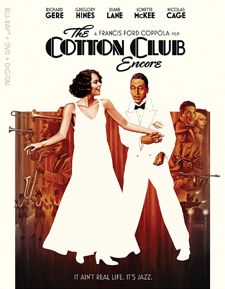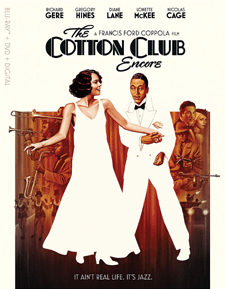Cotton Club Encore, The (Blu-ray Review)

Director
Francis Ford CoppolaRelease Date(s)
1984 (December 10, 2019)Studio(s)
American Zoetrope/Orion Pictures (Lionsgate Home Entertainment)- Film/Program Grade: A-
- Video Grade: B+
- Audio Grade: A
- Extras Grade: D
Review
The new Blu-ray release of The Cotton Club Encore, directed by Francis Ford Coppola, is essentially a Director’s Cut, though it’s not advertised as one. The term Encore suggests a second look and, according to the liner notes, “represents Coppola’s fully realized vision.” This version keeps the basic storylines but expands musical numbers to make this more of a movie musical with a gangster/love story subplot than vice versa.
Coppola uses Harlem’s Cotton Club of the 1920s to develop the relationships among its performers and the colorful gangsters who frequent the club. Cornet player Dixie Dwyer (Richard Gere) saves the life of mobster Dutch Schultz (James Remar) during an attack at the club. In appreciation, he hires the young musician to escort his girlfriend Vera (Diane Lane), particularly when his wife is present. Simultaneously, the club hires Sandman Williams (Gregory Hines) and his brother Clay (Maurice Hines) as a dance act, and Sandman meets attractive blues singer Lila Rose Oliver (Lonette McKee). Subplots include Dixie’s hotheaded brother Vincent (Nicolas Cage) kidnapping gangster Frenchy Demarge (Fred Gwynne), Dixie becoming an actor, and underworld machinations involving Lucky Luciano (Joe Dallesandro).
The strength of this new version, however, is the musical sequences, many now included in their entirety. These range from McKee’s solos in Ill Wind and Stormy Weather), terrific dance duets by the Hines brothers, chorus numbers, specialty acts, and blues belters. Beautifully staged by Coppola and choreographer Henry LeTang, they so dominate the restored version that what was the main storyline (Dixie and Vera) now seems like filler. The music is constant, either front and center or as background. Other featured songs include Creole Love Call, Copper Colored Gal, Smoke Rings, Doin’ the New Lowdown, and Minnie the Moocher.
However, there are still problems with the film. In using the Cotton Club as a metaphor for prohibition-era New York, Coppola and his co-writer William Kennedy have created an intriguing group of characters but placed them in a convoluted series of situations. The energy is infectious, and it’s hard not to respond to the performances. Ms. McKee is a good actor but she really comes alive with a great song. Real-life personalities Duke Ellington (Zane Mark), Charlie Chaplin (Gregory Rozakis), Cab Calloway (an excellent Larry Marshall), and others mingle with fictional ones in this crazy quilt portrait that both celebrates an era and illustrates its simmering tensions that often erupt into violence. Underlying it all is the era’s overt racism. White characters casually use insulting language toward black characters, a black doorman turns away any nonwhite clientele, and black staff members and performers must use a back entrance.
Richard Sylbert’s production design effectively suggests the period, with Milena Canonero’s costumes reflecting the jazz era. Performers wear elegant costumes, with sequins, glitter, and feathers adorning chorus girls. Vera’s elegant dresses reflect her taste for the finer things money can buy. Men wear tuxedos or suits and Dixie’s hair is slicked down. The interior of the club is the primary location, with its stage, back rooms, meticulously set tables, kitchen, stairways, and basement. The main entrance, with its distinctive awning, is shown often as characters enter or leave.
Coppola gave in to distributors in 1984 who wanted a shorter film than his two-hour-plus cut. The movie went way over budget and took five years to complete, but critical reaction was generally positive. Coppola subsequently spent $500,000 of his own money between 2015 and 2017 to restore the film to its original length of 139 minutes. It debuted at the Telluride Film Festival in September, 2017—33 years after the original—as The Cotton Club Encore.
The Blu-ray release, featuring 1080p High Definition, is presented in the widescreen format of 1.85:1. Lighting ranges from soft, with small table lamps on the customer tables, to high key for the performances. For the Creole Love Call number, the soloist is backed by an orchestra bathed in blue light. Film noir-type lighting with a pattern of rain on the windows is reflected on the faces of Dixie and Vera. When they are in bed, the pattern of a screen plays across their faces, suggesting they’re both in emotional prisons. Stephen Goldblatt’s cinematography romanticizes the legendary Cotton Club while dramatizing its inherent racism and the underworld schemes hatched within its walls. Musical numbers are filmed with few cuts to give the full flavor of the choreography. Coppola and Goldblatt include close-ups of Sandman and Clay tapping.
The soundtrack is English 5.1 Dolby TrueHD. Available subtitles include Spanish and English (for the hearing impaired). The sound is rich throughout. Actors deliver their lines with clarity and, even though most of the action takes place in the Cotton Club with music in the background, dialogue, music, and ambient sound are nicely balanced. The tap numbers resonate with the rat-tat-tat tapping by the Hines brothers and gunshots are sweetened both for shock and dramatic punctuation. Shultz’s murder of a rival gangster is unexpected—extremely violent and messy—emphasizing the gangster’s short fuse. The music is virtually nonstop. Songs such as I Don’t Want You No More, The Lady With the Fan, Cotton Club Stomp, Mood Indigo, Drop Me Off in Harlem, and Crazy Rhythm are performed either as on-stage numbers or for atmospheric background. John Barry’s score serves as a transition between scenes and for montages of significant events, such as the 1929 stock market crash.
Bonus materials on the 2-Disc Blu-ray/DVD Combo Pack include an introduction to the film by Francis Ford Coppola and a Q&A. A Digital copy on a paper insert is contained.
Introduction to The Cotton Club Encore – Francis Ford Coppola briefly comments on his rethinking and reworking of the original cut of the film. By adding footage, he was able to allow the story to unfold more clearly. More promotional than informative, this introduction fails to go into any significant detail.
The Cotton Club Encore Q&A – This Q&A took place after a screening of The Cotton Club Encore at the New York Film Festival. Director Francis Ford Coppola and actors Maurice Hines and James Remar are on stage for a very brief session. Coppola notes about the movie that “I couldn’t leave it alone.” Hines’ grandmother was an original Cotton Club showgirl and was amazed at how accurately Coppola recreated the club and its atmosphere. Hines speaks of how kind and thoughtful a director Coppola was. The director refers to a war going on during production in reference to disagreements he was having with Robert Evans and the financiers, yet fails to go into much detail. Remar comments that the screening “feels like the premiere The Cotton Club should have gotten.” About 40 minutes of footage was added because the original cut was out of balance. Some of the “powers that be” felt that the movie skewed too much to the story of the black characters and that a predominantly white audience unfamiliar with black people and their lives would not respond well. Coppola, who had strong disagreements with Robert Evans during the making of the film, dedicated the film to Evans, who had the original idea for the film and hired much of the talent. Because Evans was having trouble raising the financing, he approached Coppola to make the project more attractive to investors. Coppola met with Evans, Richard Gere, and Gregory Hines and “little by little, I got suckered in.”
– Dennis Seuling

